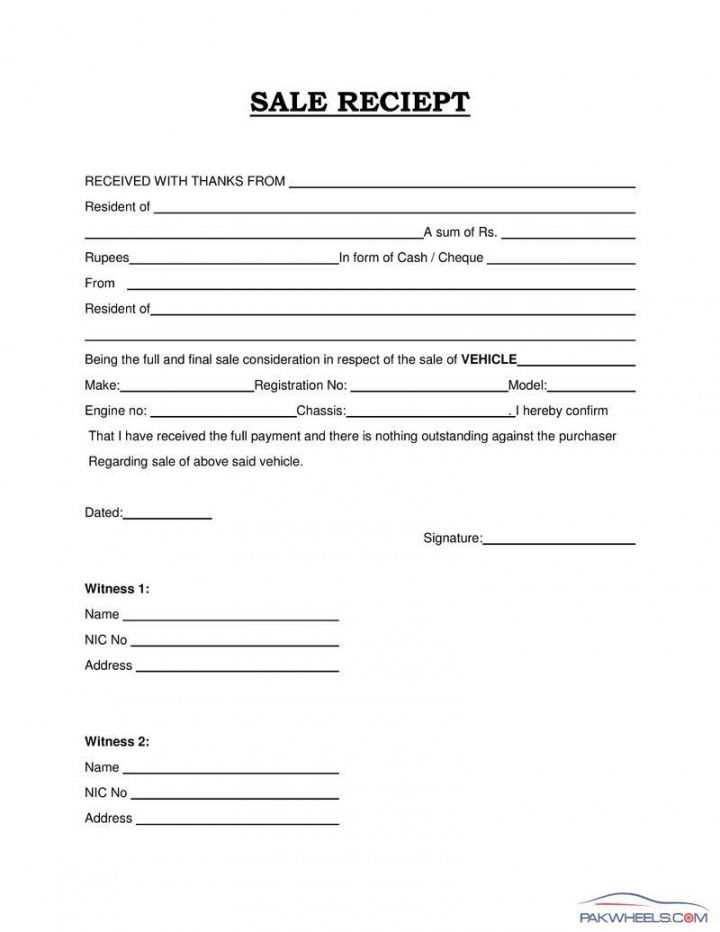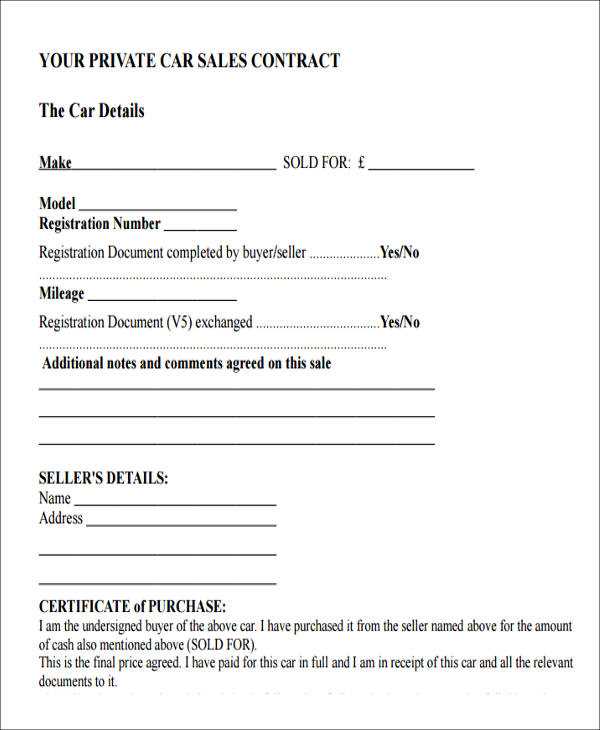
Ensure that both parties clearly understand the terms of the car sale by using a well-structured receipt template. A sale receipt serves as a formal agreement, providing both the seller and buyer with important details regarding the transaction. The template should include information about the vehicle, payment, and any additional terms agreed upon.
Include the car’s make, model, year, and VIN (Vehicle Identification Number) to clearly identify the item being sold. Also, note the sale price, payment method, and date of the transaction. It’s recommended to include a clause that states the car is being sold “as is,” unless specific warranties or guarantees are offered.
Provide clear contact details for both the buyer and the seller. This ensures that any follow-up regarding the transaction can be handled smoothly. You can also add a section for signatures to formalize the sale and make the document legally binding.
Finally, make sure to include any extra details that may be relevant, such as whether a deposit was made, the balance due, or whether the buyer has received all necessary paperwork, such as the car’s title and maintenance history. A well-prepared receipt can help avoid disputes and protect both parties.
Template for Car Sale Receipt
Use a straightforward layout for a car sale receipt to avoid confusion. The template should include key details such as the buyer and seller’s information, vehicle details, payment method, and terms of the sale.
Buyer and Seller Information

Include full names, addresses, and contact details for both the buyer and the seller. This ensures there is no ambiguity regarding the parties involved in the transaction.
Vehicle Information
List the vehicle’s make, model, year, Vehicle Identification Number (VIN), mileage, and any relevant features or condition notes. This helps confirm the exact vehicle being sold and avoids future disputes.
For payment details, specify the amount received, the method (e.g., cash, bank transfer), and the payment date. If any outstanding payments remain, outline the terms for these. Include any warranties or guarantees provided by the seller, along with the date the sale is finalized.
Key Information to Include in the Receipt
The receipt should clearly list the buyer and seller information, including full names, addresses, and contact details. This ensures both parties are identifiable for future reference.
Vehicle Details

Include the make, model, year, Vehicle Identification Number (VIN), and mileage of the car. This information links the receipt to a specific vehicle and avoids any potential confusion.
Transaction Information
State the sale price of the car along with any applicable taxes or fees. Specify the payment method, whether it’s cash, check, or financing, to provide clarity on how the transaction was completed.
Record the date of sale to establish the timeline. This is important for any future questions about the transaction or warranty claims.
Formatting the Payment Details Section
Ensure clarity and precision when laying out the payment information. Include key details such as the total amount, payment method, and any deposits made.
Payment Amount Breakdown

List the full price of the vehicle along with any additional charges (e.g., taxes, fees). Present these amounts in separate lines for better readability.
- Vehicle Price: $20,000
- Sales Tax (8%): $1,600
- Additional Fees: $200
Payment Method

Clearly state the method of payment used by the buyer, whether it’s cash, check, credit card, or financing.
- Method: Credit Card
- Amount Paid: $5,000
- Remaining Balance: $16,800
If applicable, include payment schedules for installment plans or financing agreements. Specify any deposits made upfront to avoid confusion.
Legal Aspects of Car Sale Receipts
Ensure the receipt includes the full names and addresses of both parties involved, the buyer and the seller. This information helps prevent future disputes about ownership. Specify the vehicle’s make, model, year, and VIN number, as this confirms the exact item being sold. Clarify the transaction amount, including any taxes, fees, or deposits paid. Also, clearly state the payment method used, whether it’s cash, check, or financing. The date of sale is another key detail; it serves as the official transfer of ownership.
Incorporate a statement regarding the condition of the vehicle, noting if it is sold “as is” or with warranties. When sold “as is,” the buyer accepts the vehicle without recourse for defects that may arise later. If there are warranties, specify what they cover and the duration. If the transaction involves a trade-in vehicle, ensure it’s listed separately with its agreed value.
The receipt should include a section where both parties sign, acknowledging the completion of the sale. This adds legal weight and provides a record of mutual consent. If applicable, include a disclaimer about any claims related to the vehicle’s past history, especially if the seller is not the original owner.
Finally, make sure the receipt is in compliance with state-specific regulations. Different states may have additional requirements, such as odometer readings, emission testing, or environmental considerations. Always consult local laws to ensure the document is fully compliant and valid.


